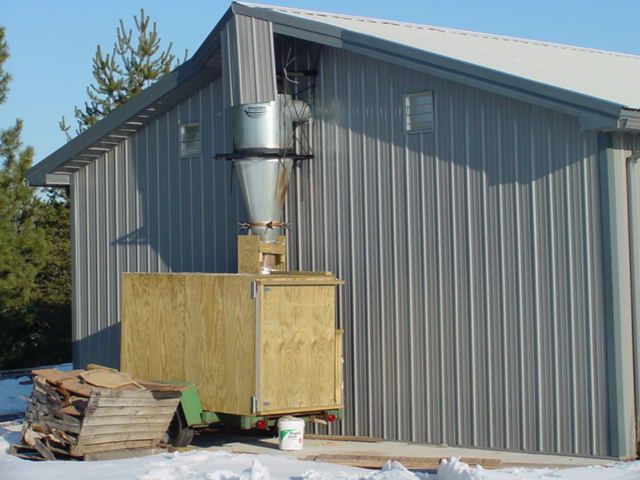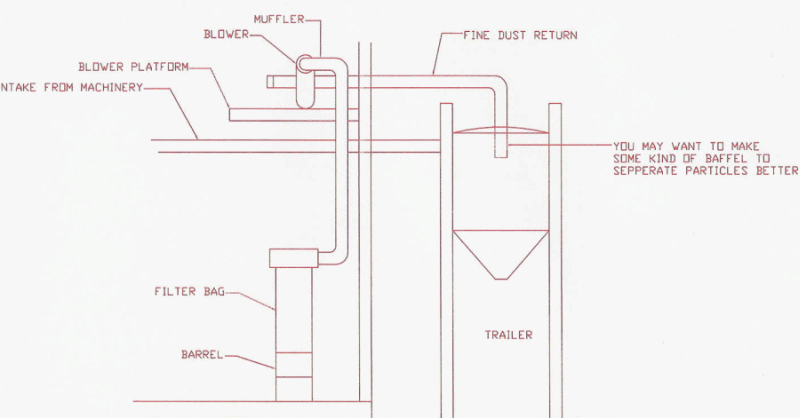Dust Collection Direct to a Trailer
Other Versions
Spanish
French
Shop owners discuss ways to rig a dust collection cyclone so it dumps directly into a trailer. September 24, 2006
Question
Can I direct the dust from my cyclone right into an enclosed trailer? I have a tilt bed trailer that I would like to customize for the use. We have a difficult time keeping up with the barrel changing. Has anyone else done this?
Forum Responses
(Dust Collection and Safety Forum)
From contributor J:
I work at a cabinet shop that has an enclosed trailer thatís under a cyclone dust collector just as you stated. It works great. He has a rubber spout in the bottom of the cyclone that goes into the trailer and doesnít require taking anything loose to move the trailer to empty it. He also has his cyclone outside, which is convenient. A farmer comes and gets the trailer about every six months and uses the sawdust for bedding. I am planning on opening a shop of my own in a few years and doing this same thing. My plan is to just buy a blower and find an old small grain bin to use for the cyclone and make a pickup box enclosed trailer. So, yes, it can be done and it works great. I also can imagine having a hard time keeping up with barrels.
From contributor G:
You need a rotary air lock at the bottom of the cyclone. This unit discharges the dust but maintains an air tight seal. Contributor J, cyclones must be designed correctly for your needs. I doubt that you will have much luck with an old grain bin. Look around - you should be able to find an entire used system cheaper than you can build one.
From contributor L:
If you build the trailer air tight, you don't need an airlock. I have my cyclone/blower located at the back of my shop tucked under the gable peak overhang. Bottom of cyclone is about 8ft above the ground. Trailer is below. Try to keep the cyclone out from the building far enough to allow the discharge into the center of the trailer box top. When emptying, all I need to do is remove 4 or 5 spring loaded clamps that clamp the lower half of the flex tube adapter to the cyclone bottom. I also built on the side of the trailer a ladder to enable me to reach the clamps easily.
From contributor T:
Contributor J, we have the same intentions with our new shop. I was thinking of building a directional type baffling inside the enclosed trailer to make the cyclone. As to the system you were talking about with a commercially purchased cyclone, what about the filter part of the system - the part designed to capture the smallest dust that doesn't fall? Did he just do away with that part? Contributor L, do you have the filter part in your shop for return air? Also, why does the trailer have to be completely airtight? Is this just to prevent air from returning back into the exhaust?
From contributor L:
I use 7 of the .5 or 1 micron filter tubes located inside the shop. The trailer needs to be airtight because I don't have a rotary airlock at the bottom of the cyclone. That saved me about $2000. The price I pay for that is I need to disconnect the trailer from the cyclone to empty the trailer.
From contributor G:
You need an airlock or air tight trailer. If not, the air will just be blasted out of the leaks in the trailer, dusting up the neighborhood and not properly returning into the shop. This is with a push through (fan before cyclone and/or filters) system. With a pull through (fan after cyclone and/or filters), air can be sucked out of the trailer and/or up through the bottom of the cyclone instead of through the duct work.
From contributor B:
I'd be obliged if some of you would post pictures of your system. We need to do something along this order. Pictures are of great interest.
From contributor L:
You asked for it. There is a wood ladder built into the side of the trailer next to building that allows easy access to remove the squeeze clamps that connect the bottom of the cyclone to the trailer intake. And that white stuff is Rochester sunshine. Heh heh.

Click here for full size image
From contributor J:
Here is a CAD drawing of the system I mentioned.

Click here for full size image

